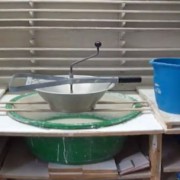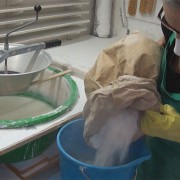GLAZE-BASE (c) Preparing the glaze-base
ca: ESMALT-BASE (c) Preparació de l'Esmalt base
es: ESMALTE-BASE (c) Preparación del Esmalte base
 Note: Before starting to apply the base the bisque must be cleaned and sounded, this is explained in the follow four sections. Read more about: Bisque (a) Cleaning tiles to use / Bisque (b) Sounding tiles / Bisque (c) Sounding plates, jars and lids /Bisque (d) Cleaning plates, jar and lids
Note: Before starting to apply the base the bisque must be cleaned and sounded, this is explained in the follow four sections. Read more about: Bisque (a) Cleaning tiles to use / Bisque (b) Sounding tiles / Bisque (c) Sounding plates, jars and lids /Bisque (d) Cleaning plates, jar and lids
Preparation:
Half fill an ordinary bucket with water, add the glaze-base in powder form and mix them. The best method is to buy a long metal whisk that can be used with an electric drill but it can be done by hand, wearing plastic gloves to press out all the lumps and stirring. Continue adding glaze-base and water until you have a bucketful with a thick, creamy texture, thoroughly mixed.
The prepared glaze-bases are kept in a containers, designed as part of a table, which are used for working in and storing. Read more about: Table – Glaze-Bases

Working Process
a) Across the container, from side to side, lay two long, strong, flat bars of wood. They should be far enough apart to balance the sieve. The sieve can be an ordinary wooden one, metal or rotary.
b) Pour the mixture into the sieve and press it through into the storage container. Discard any solid bits that cannot be broken up and are left in the sieve. When finished, clean and wash the sieve well.
Remember to scrape up and keep all the glaze-base that is dirty, dry or wet that falls off during the process of preparing and put it into the box where you keep the dirty glaze-base as it can be cleaned and used again. Read more about: Glaze-base (l) Cleaning-up / Glaze-base (i) Leaving the glaze-base
Note: Sieves: You need three; a rotary sieve rotary sieve for large quantities of glaze-bases, which comes with changeable plaques with different sizes of mesh, for a glaze-base use a mesh of 80; a normal sieve for quick jobs; and a cup lawn for colors. These last two do not have changeable mesh. The small one for colors is made in two pieces, a funnel and a sieve, and this makes passing the liquid into narrow bottles or jars very easy.
To see the next stage with tiles go to: Glaze-base (e) Applying by pouring on to tiles.
To see the next stage in plates, jar and lids go to: Glaze-base (g) Applying by dipping plates, jar and lids..
To see the video: Glaze-Base (c) Video – Stage 1 – Preparing the glaze-base.









